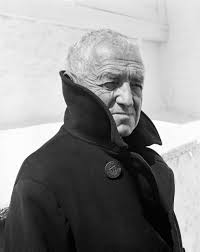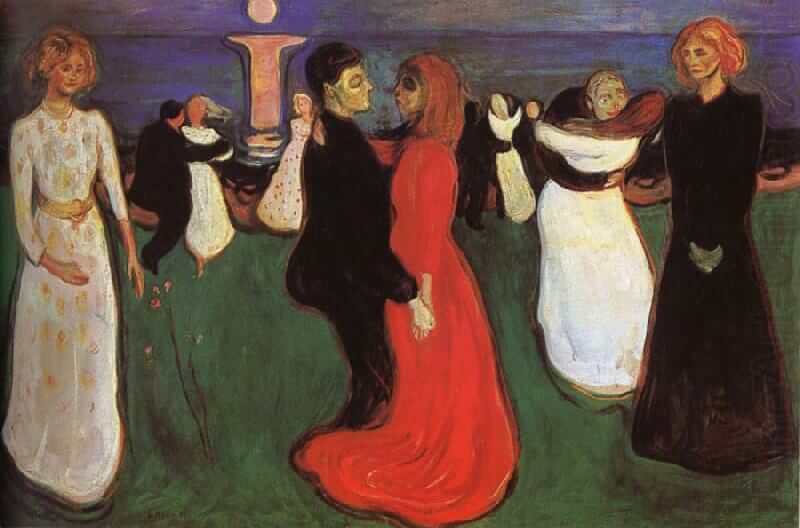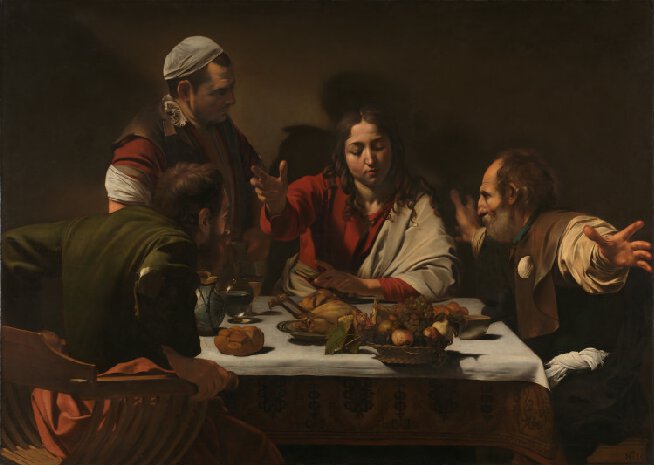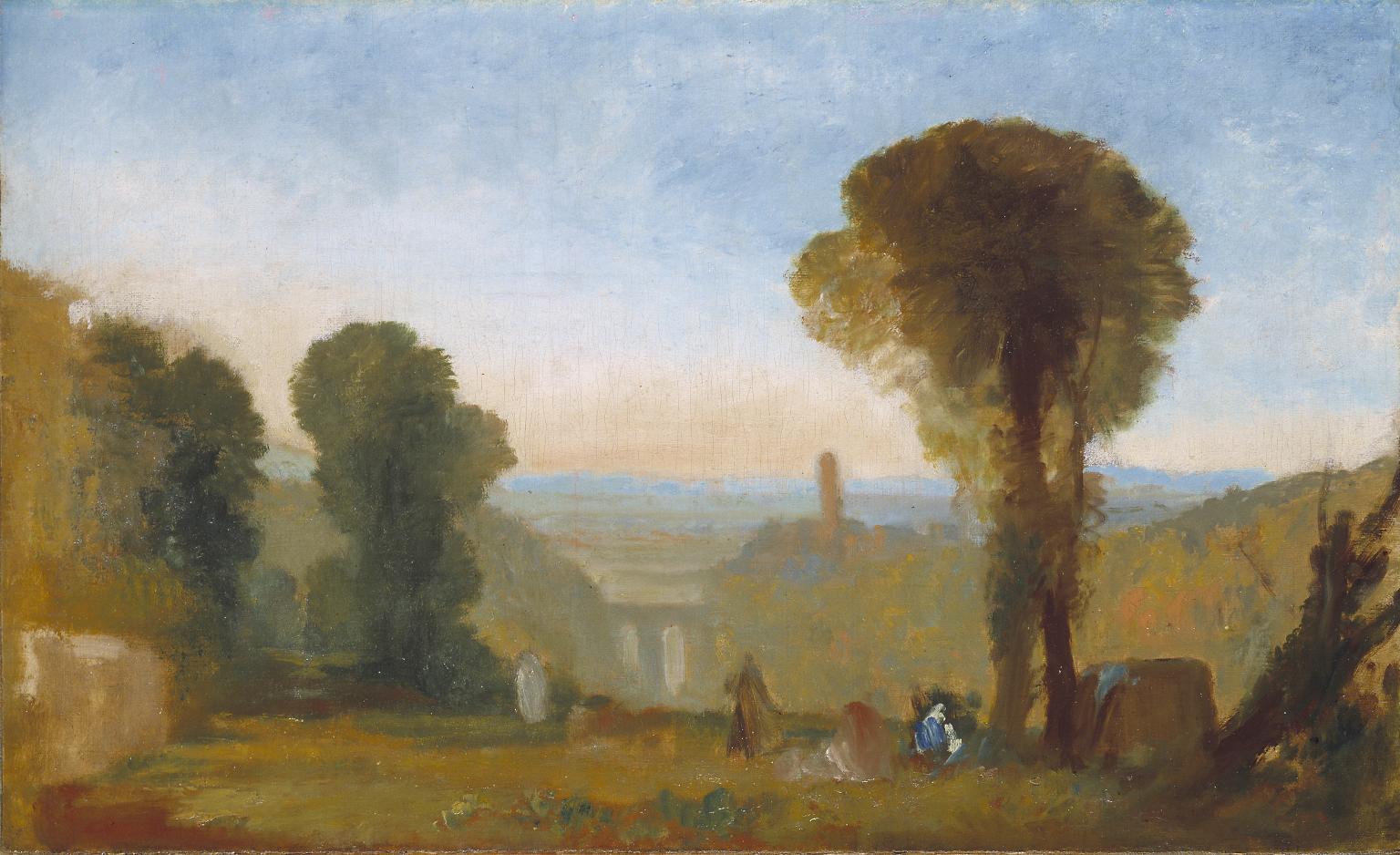10 of the Most Famous Paintings and Artworks by Andrew Wyeth
A realist painter and a visual artist, Andrew Wyeth etched most of his works in a regionalist style. He had once quoted that he painted his life and most of his artworks revolved around the picturesque landscape as well as the people he was acquainted with both in Chadds Ford, his hometown and also his summer home situated in Cushing Maine. His works were initially sketched in pencil or watercolor and then completed in dry brush, watercolor or egg tempera (learned from Peter Hurd, his brother-in-law). He passed away in 2009 in his sleep at the age of 91.
Biography of Andrew Wyeth in a Nutshell
| Full Name | Andrew Wyeth |
| Birth | 12th July 1917 |
| Nationality | American |
| Death | 16th January 2009 |
| Mentor | Howard Pyle, N.C Wyeth |
| Periods | Realism, Modern art, Regionalism |
List of Best Paintings by Andrew Wyeth
1. Christina’s World
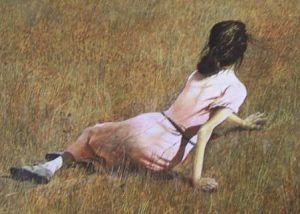 |
| Completed in: 1948 |
| Measurements: 81.9 cm × 121.3 cm |
| Location: Museum of Modern Art |
| Medium: Egg tempera on a gessoed pane |
One of the most famous American paintings to be created in the 20th century, it depicts a woman lying on a barren grassy field, having her vision fixed at a certain gray house at a distance. The lady in question is Anna Christina Olson, whom Wyeth was well acquainted with since he possessed a summer home in that particular area. She suffered from a genetic disease which affected her motor movements and was often seen by Wyeth crawling across a nearby field that was, in fact, his source of inspiration for this painting. However, his wife Betsy was the model for this painting as the person on whom the work had been made was 55 at that time. The painting reached its popularity from the time it was exhibited in MoMA (Museum of Modern Art) in New York. The house depicted is the Olson House located in Cushing, Maine and has become a public site.
2. The Helga Pictures
 |
| Completed in: From 1971 to 1985 |
| Location: Private Collection |
| Medium: Tempera on panel, dry brush on paper, watercolor on paper |
It is a series of about 245 paintings (200 drawings, 45 paintings) featuring Helga Testorf from 1971 to 1985. Testorf, Wyeth’s neighbor in Pennsylvania, posed for him in a lot of paintings clothed and even nude. Those sessions where she featured sans her clothes was a complete secret and hidden from their respective spouses, the paintings kept at Frolic Weymouth’s (Wyeth’s best confidant and student) home. This approach of his has been subjected to a lot of criticism, also being said to possess similarity with the techniques of Manet and Botticelli. Some have even gone to the extent of mentioning this series to be voyeuristic to a certain extent. Some of the works include Letting Her Down (1972), Black Velvet (1972), Lovers (1981), Barefoot (1992), and Helga’s Black (1991).
3. Wind from the Sea
| Completed in: 1947 |
| Measurements: 47 cm × 70 cm |
| Location: National Gallery of Art, Washington, D.C. |
| Medium: Tempera on hardboard |
This is a magnificent work of art where the inner view of an opened attic window, with the wind blowing the tattered curtains, present inside the room is projected. The house was that of Alvaro and Christina Olson, Wyeth’s friends, who even appeared in some of his paintings. The artist was working in the attic, and suddenly the curtains came into life when blown by a breeze from outside. This inspired him to put such a solemn painting on canvas. Wyeth believed that ordinary objects of our daily living came with an immense symbolism and a lot of emotions, and this artwork bears testimony of the same. The decaying curtains stand for Christina’s disability, the crocheted birds symbolize her femininity, while the decayed interior and cemetery, at a stretch stand for the ultimate fate everyone would be subjected to some day of the other.
4. Winter 1946
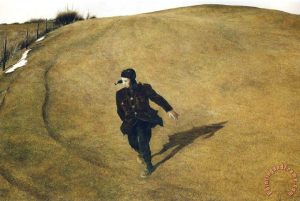 |
| Completed in: 1946 |
| Measurements: 79.7 cm × 121.9 cm |
| Location: North Carolina Museum of Art |
| Medium: Tempera on board |
Another significant of Wyeth’s painting, showing a boy pacing down a hill, with the backdrop set to winter. This was actually made post his father’s death. He claims that the figure depicted in the painting is that of his own self, engulfed in a sea of grief.
5. Trodden Weed
 |
| Completed in: 1951 |
| Measurements: 50.8 cm × 46.35 cm |
| Location: Private collection |
| Medium: Tempera on board |
A remarkable self-portrait, showing Wyeth clad in a pair of old leathered high boots received as a gift in 1950 from his wife for Christmas. The boots were originally owned by Howard Pyle, the teacher of Wyeth’s father. Betsy had acquired it from another student of Pyle and presented it to her husband. Wyeth had undergone an operation with a part of his lungs removed at that juncture when the painting had been created. This is said to have an autobiographical symbolism, and the boots may have refreshed several of his childhood memories.
6. That Gentleman
 |
| Completed in: 1960 |
| Location: Dallas Museum of Art |
| Medium: Tempera on panel |
This is a biographical portrait of another of Wyeth’s neighbors, Tom Clark who was of Afro-American descent. The painting reflects only his back, while the face remains concealed from the viewers. The brown aura surrounding Mr. Clark highlights Wyeth’s technique of trimming away significant details in his work of art which creates a sense of ambiguity. According to Wyeth, Clark was wise and witty with a gentle voice. This painting reminds us of many such unsung heroes who go unnoticed.
7. Evening at Kuerners
 |
| Completed in: 1970 |
| Measurements: 64.8 cm × 101 cm |
| Location: Private Collection |
| Medium: Seattle Art Museum |
Wyeth had a strong association with the Kuerners Farm which occupies a significant place in many of his works of art. It had been painted at a time when Karl Kuerner Jr, the son of the owner was ailing. The white farmhouse surrounded by leafless trees and a thin stream of water creates a feeling of desolation and dreadfulness.
8. Turkey Pond
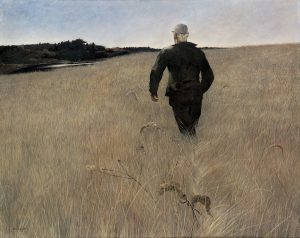 |
| Completed in: 1944 |
| Measurements: 84 cm x 104 cm |
| Location: Art Museum Farnsworth |
| Medium: Tempera on panel |
Made on tempera on panel, this is another soulful painting of Wyeth reflecting a man walking solitarily through a grass field.
9. Groundhog Day
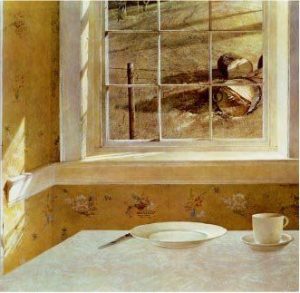 |
| Completed in: 1959 |
| Measurements: 79.7 cm × 81.6 cm |
| Location: Philadelphia Museum of Art |
| Medium: Tempera on panel |
Most of the several prints he made possess a simple yet bleak and mournful atmosphere, and this one is no exception. This artwork depicts a dull and gloomy view outside a window where one can observe dead grass that has turned brown as well as a fallen tree with jagged edges. However, the room inside is poles apart from the outer view, neat and tidy, decorated with flowery wallpaper, and nice table arrangements. In fact, in this way he tries to present the contrasting situations, pairing the harsh with gentle, pitting order against disorder as well as a weakness with strength. The title is also an interesting one as Groundhog Day indicates the transition of a season, from winter to spring, thus combining a sense of disappointment with a ray of hope.
10.Farm Pond
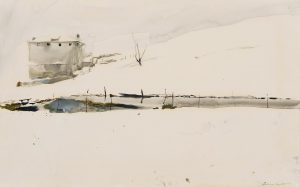 |
| Completed in: 1957 |
| Measurements: 33.7 cm x 54 cm |
| Location: Museum of American Art |
| Medium: Watercolor on Paper |
An amazing watercolor painting, presenting a pond, sketched at the center, with black vertical lines which stand for fence posts. The Kuerner’s farmhouse can be seen at a distant with two chimneys alongside four dark squares that look like windows. A leafless tree sits at the middle, while the cloudy sky has been depicted through the watery brushstrokes. The sense of loneliness and bleakness has been brilliantly portrayed through this painting.
His other remarkable paintings and artworks include Flood Plain, Self Portrait, Dodges Ridge, Burning Off and Flat Boat.
Subscribe now
Get lasest updates in your inbox

